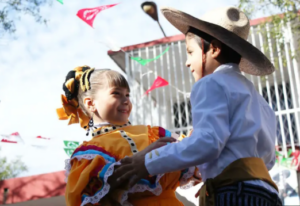If you’re from South Texas or Mexico, it’s very likely that you have at least a small bit of knowledge as to what Mexican Folk Dancing is: the art of dancing in beautifully colored dresses, telling their own story through their dance movements. Mexican Folkloric Dancing is very important in Mexico as it is one of the many ways that the people of Mexico celebrate their culture, independence, and ancestors.
The Mexican Hat Dance is one of the most popular Mexican Folk dances in Mexico. Originating from the state of Jalisco, the Mexican Hat Dance became one of the most popular dances in Mexico and soon made its way to South Texas. Jalisco is not only home to the Mexican Hat Dance, but it is also home to mariachi bands, the China Poblana female and Charro male costumes, and other Jarabe dance forms.1

The Mexican Hat Dance is usually performed by a couple (a man and a woman), where the dancers do not touch each other, but show the courtship between the each other.2 The Mexican Hat Dance, also known as “el Jarabe,” is a dance of flirtation. In the beginning of the dance, the woman is shy and timid, while the man is attentive and persistent. In most versions, the man tosses his sombrero on the floor so that he and the woman can dance around it.3 Most people from Guadalajara (a city in Jalisco) call the Mexican Hat Dance “el Jarabe Tapatio.” Jarabe means a specific mestizo song and dance form, and Tapatío is a term that is used to refer to the people of Guadalajara.4 This is why dancing is such an important art in Mexico. Although there are many forms of el Jarabe (The Mexican Hat Dance), el Jarabe Tapatio is the most important to the people of Jalisco–especially the people of Guadalajara. El Jarabe Tapatio gives a name to the people of Guadalajara and it lets everyone who performs their dance know that they are performing the dance of Guadalajara.
In the early 1900s, Anna Pavlova—a great Russian Ballerina—made the Mexican Hat Dance part of her repertoire and the Mexican Hat Dance became the “National Folk Dance” of Mexico.5 When Anna Pavlova fell in love with the dance and made it part of her repertoire in 1919, the ecstatic Mexican cultural authorities felt that it was an honor and that it could only mean that the Mexican Hat Dance was indeed the most important dance in Mexico. Thus it was decided, since it was such an important dance, that it should be danced wearing the “China Poblana” outfit. The outfit is a beautiful green, wide brimmed skirt with colorful sequence and a coordinating white blouse.6

The Jarabe Tapatío, or the Mexican Hat Dance, is a Mexican folk art that signifies the Mexican identity. Not only does it commemorate a sense of unity throughout the country of Mexico, it also showcases the traditions and culture of Mexico.7 Since its popularity came about during the Mexican Revolution, it brings a sense of cultural identity to the Mexican people: being able to showcase who they are and what they love through the beautiful art of dancing. Dancing in Mexico is a very important part of their culture as they use it to express themselves and to showcase who they are. The beauty and vividness of the dresses and the grace of the dancing are what have captivates audiences around the world.
Today, Mexican Folkloric dances are seen all throughout Mexico and all throughout South Texas. From festivals to basic social gatherings and even in dance competitions; not only is the Mexican Hat Dance seen, but many other forms of Mexican Folk dances are seen all throughout. Even in places like Fiesta, the ten-day long celebration that takes place in downtown San Antonio, citizens see Mexican Folkloric dancing take place all throughout the Fiesta celebration. The Mexican Hat Dance is not just a dance to the people of Mexico, rather, it is a way of showcasing to the rest of the world who the people of Mexico really are.
- Anthony Shay, Choreographic Politics: State Folk Dance Companies, Representation and Power (Middletown, CT: Wesleyan University Press, 2002), 40-41. ↵
- Jose Luis Ovalle, “The Mexican Hat Dance: National Folk Dance of Mexico,” Mexican Dance Company, 2007, http://mexicandancecompany.org/mexican-dance/mexican-hat-dance.html. ↵
- Encyclopedia Britannica, June 2017, s.v. “Jarabe: Mexican Dance.” ↵
- Brenda M. Romero, Dancing Across Borders: Danzas Y Bailes Mexicanos (Urbana and Chicago: University of Illinois Press, 2009), 287. ↵
- Jose Luis Ovalle, “The Mexican Hat Dance: National Folk Dance of Mexico,” Mexican Dance Company, 2007, http://mexicandancecompany.org/mexican-dance/mexican-hat-dance.html. ↵
- Jose Luis Ovalle, “The Mexican Hat Dance: National Folk Dance of Mexico,” Mexican Dance Company, 2007, http://mexicandancecompany.org/mexican-dance/mexican-hat-dance.html. ↵
- Jose Luis Ovalle, “The Mexican Hat Dance: National Folk Dance of Mexico,” Mexican Dance Company, 2007, http://mexicandancecompany.org/mexican-dance/mexican-hat-dance.html. ↵


54 comments
Caden Floyd
Being from South Texas I see this kind of dancing all the time at birthday parties and weddings to festivals commemorating well known hispanics. I never knew that it meant this much to the people of Mexico. It seems like Anna Pavlova really helped spread the beauty of this folk dance and it makes me happy to hear that the Mexican people were happy to spread their favorite dance around the world. Before I read this article I thought the Mexican Hat Dance was just a silly thing, but now I realize how much it really means to proud Mexicans.
Nathan Alba
I have heard of the dance, but was not familiar with its origins. I did not realize it was such a part of culture here in south Texas, mostly because I am not from Texas. I did like how the article went into detail describing how it transformed into the dance of a nation. Experiences, such as this dance are great examples of how people from all over can enjoy different cultures.
Jorge Martinez
I think it is important that someone stays true to their roots. I am a proud Mexican-American and I appreciate the historical importance of my people. My first recollection of the “Mexican hat dance” was in elementary school. Growing up in San Antonio, I am always reminded of this dance and why it is important. When I am older and have my own family, I want to make sure that my own children understand the importance of the Mexican culture.
Sienna Guerra
Being Hispanic, I was never heavily involved in the Mexican culture like this but loved to watch the culture be spread through dance like the Mexican Hat Dance. I have known what folkloric dancing was since I was little but the original name for the dance. I love the vibrant colors the dresses are and the stomping of the feet or use of maracas and instruments included in their dance is fierce.
Montserrat Moreno Ramirez
I think this article really nailed it by explaining the real meaning of “el jarabe tapatio” since it reflects my cultural identity and exposes how many people from all around the world feel about it, It was really great to find out that a recognized dancer like Anna Pavlova would refer to the dance as part of her repertoire. This article also let people know many important aspects about the dance such as the way it’s danced, the outfit, people involved, among other aspects.
Tyler Boyd
I have seen pictures and video of the Mexican Hat Dance but didn’t know the history and cultural significance that it carried. After reading this article and now being in San Antonio I’m going to try my best to experience this incredible tradition in person. One of the most intriguing things in my opinion is how a Russian ballerina gained the attention of Mexican cultural authorities and made them realize that it is truly the most important of the Mexican dances.
Micaela Cruz
I come from a large Mexican-American family, however, I personally don’t know a lot about the culture of Mexico unfortunately. I had heard of Mexican Folkloric dance before and I always thought of it as a beautiful display of art. Watching the dancers and the ways the represent their culture and people is admirable; I found this article very interesting as it gave me a deeper insight to an aspect of the Mexican culture that I was familiar with prior to reading the article. What I found astonishing was how Anna Pavlova, a Russian ballerina, made the Mexican Hat Dance part of her life and turned it into something so recognizable to all of Mexico, it’s truly brilliant.
Natalie Juarez
I never knew about the Mexican Hat Dance until after reading this article, which tells me that I need to learn more about Mexican culture since most of my family is from Mexico. I do know that the people of Mexico love the art of dancing, so it makes sense how important the dance is to them. Coming from a Mexican background, there is always dancing in every fiesta or social gathering that my family has. That is because dancing really is important and dear to our hearts! Your article made me smile because it reminded me of how lively, colorful, and beautiful Mexican culture is!
Irene Astran
I’ve always appreciated this dance. When I see it danced I think of it like I am watching a play. The woman is taking the time she needs to get familiar with the man. I like that the man shows his interest in that he continues to be gentle and present. The way I usually seeing this dance end is with the man picking up the hat to cover their faces as they go in for a kiss. I think it is really sweet because it is a tiny love story being played out in song and dance.
Jasmine Rocha
Being Mexican American sometimes we don’t get too in touch with the origin and in general our cultures from our brothers and sisters from Mexico. This article made want to learn not only more about my Mexican heritage either by speaking to my family members in Mexico and my dad but also do my own research on it. I always knew that many Mexicans are proud when it came to their culture and country but this brought a whole new meaning to why my dad was proud and why I should be proud to at least be half Mexican. Not only is it fun to know more about the history and meaning of my Mexican culture but now I want to know more about my Salvadorian culture because currently I only know how to make pupusas and don’t know their history or importance in the Salvadorian communities.